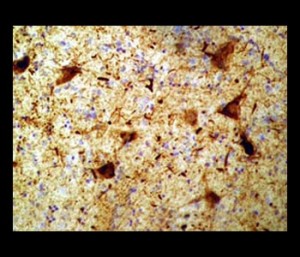Chris Henry’s Damaged Brain

Yesterday, scientists at the Brain Injury Research Institute (BIRI) of West Virginia University, announced that the late Cincinnati Bengals wide receiver, Chris Henry, had chronic traumatic encephalopathy (CTE) at the time of his death. Mr. Henry, 26, died on Dec. 17, 2009, after suffering severe head trauma when he either jumped or fell from the back of a moving pickup truck being driven by his fiancée. The two had been involved in a dispute before Henry jumped into the truck.
Chronic traumatic encephalopathy is a form of brain damage which is believed to be caused by repeated concussions. Originally described in boxers, and called dementia pugilistica (DP) (commonly called “punch drunk”), symptoms include memory impairment, speech and gait problems, Parkinsonism, tremors and lack of coordination. Early on there may be emotional instability, erratic behavior, depression and problems with impulse control. Eventually it leads to full-blown dementia. Floyd Patterson, Sugar Ray Leonard, and Muhammad Ali are all suspected to be victims of DP.
In 2002, Dr. Bennet Omalu, a forensic pathologist and neuropathologist in Allegheny County, Pennsylvania examined the brains of four professional football players who had histories of repeated concussions. Microscopic findings where identical to those found in DP, and he renamed the condition chronic traumatic encephalopathy.
 The disease is characterized by the build-up of a toxic protein called tau in the form of neurofibrillary tangles (NFTs) throughout the brain (brown areas in the picture at left). These tangled clumps of protein are abnormal and found within the nerve cells in the brain. They were first described by Dr. Alois Alzheimer in one of his patients suffering from dementia. These tangles interfere with the normal functioning of the brain and eventually kill brain cells. Although the dementia of CTE is similiar to that seen in patients with Alzeheimers Disease, they are different conditions.
The disease is characterized by the build-up of a toxic protein called tau in the form of neurofibrillary tangles (NFTs) throughout the brain (brown areas in the picture at left). These tangled clumps of protein are abnormal and found within the nerve cells in the brain. They were first described by Dr. Alois Alzheimer in one of his patients suffering from dementia. These tangles interfere with the normal functioning of the brain and eventually kill brain cells. Although the dementia of CTE is similiar to that seen in patients with Alzeheimers Disease, they are different conditions.
The distribution of the damage is widespread, including the cerebral cortex (which includes the frontal and temporal lobes), the thalamus, hypothalamus, brainstem and spinal cord.
Unfortunately, CTE can only be diagnosed at autopsy using special tests that are not routinely performed.
Boston University, at its Center for the Study of Traumatic Encephalopathy, studied the brains of eleven professional and college football players. All had evidence of CTE. Eight died suddenly in middle age, and seven experienced “tragic deaths”- three from suicide, two from substance abuse, one during a high-speed police chase and one accidental gunshot while cleaning his gun.
Dr. Omalu also tested the brain of WWF wrestler Chris Benoit. In 2007, Benoit had killed his wife and son before hanging himself. Dr. Omalu’s studies showed CTE in all areas of Benoit’s brain.




























1 Comment